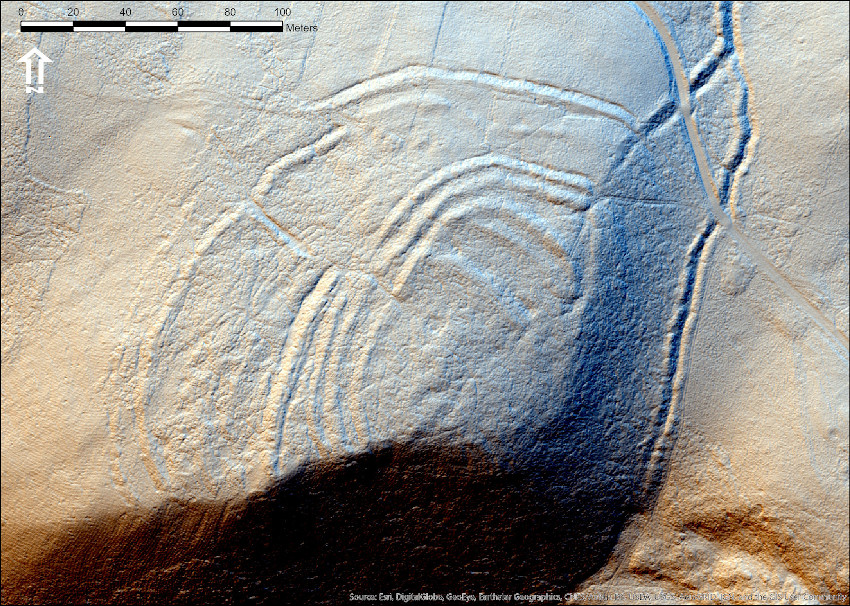The hillforts of the Lammermuirs are some of the area’s most distinctive and impressive archaeological sites. Around 2500 years ago, in the early Iron Age, settlements began to be built on hilltops, promontories and around steep slopes and cliffs- locations that were deliberately intended to appear defensive and impenetrable. Most of these settlements, as well as others that had continued in occupation from the late Bronze Age, were also enclosed by monumental earthworks: banks and ditches supported or enhanced by palisade fences designed to fortify the living space within. These hillfort settlements are the distinctive signature of the Iron Age in south-east Scotland, leaving a recognisable imprint on the landscape to this day. LiDAR survey allows visualisation of these spectacular sites at an unprecedented level, allowing phases of earthwork construction and modification that reflect activity over hundreds of years to be identified.
White Castle
Perched on the shoulder of the Lammermuirs overlooking the East Lothian plain, White Castle has one of the most commanding aspects of any hillfort in the study area. Excavations carried out between 2010 and 2014 produced evidence at the site dating from the Neolithic, but the major fortified settlement was first constructed in around 400 BC. Activity apparently continued sporadically throughout the first millennium BC, with a final refurbishment of the defences perhaps occurring around 200 BC. There are traces of at least 18 roundhouse stances within the interior.
Edins Hall
An iconic Scottish fort, Edin’s Hall has Long been a curiosity, owing to the dominating presence of a broch, or drystone tower, built within the interior. Brochs are not common outside of the north and west of Scotland, with most found in the Western and Northern Isles. What prompted this status symbol to be built at Edin’s Hall is uncertain, but archaeologists have speculated that it could have operated as symbol of northern resistance in the face of the advancing Roman army.

Hopes
The complex fort at Hopes is a good example of how the multiple phases of occupation and rebuilding result in numerous rings of ditch and bank rampart defences over many years of use. Although never excavated, like other forts in East Lothian, Hopes was probably first established in the third quarter of the first millennium BC. The LiDAR terrain model identifies a narrow palisade slot within the interior, with numerous other palisade trenches visible associated with the more substantial ramparts.
Wrunklaw
An unusual precipitous promontory location was chosen as the defensive position for Wrunklaw fort. A deep ditch cuts the settlement off from the land to the west, while a massive earth and stone rampart would have created an imposing façade. Long after the original Iron Age fort was abandoned, the site was reoccupied as a farmstead, and numerous oblong buildings are visible. The semi-circular mound on the north side may be the remains of a grain drying kiln related to this historic activity.
Shannabank
High on the river terrace above the Whiteadder at Abbey St Bathans are the remains of Shannabank fort. The D-shaped annex and associated small stone huts were likely built in the later Iron Age, once the original ramparts had become dilapidated; a similar pattern is identifiable across the hillforts of the south east of Scotland. The interior of the fort and the surrounding fields have been overwritten by the sweeping S-shaped furrows of medieval cultivation.
Cockburn Law
One of the most imposing forts of the Whiteadder valley, Cockburn Law commands views of the surrounding landscape. The in-turned entrances direct those approaching the gates to their left, a tactic often used in the design of forts with a more militaristic mentality, thereby exposing the non-shield bearing side of attacking troops. On the terraced slopes to the east, a small late Iron Age settlement has been constructed, probably after the main fort was abandoned.

